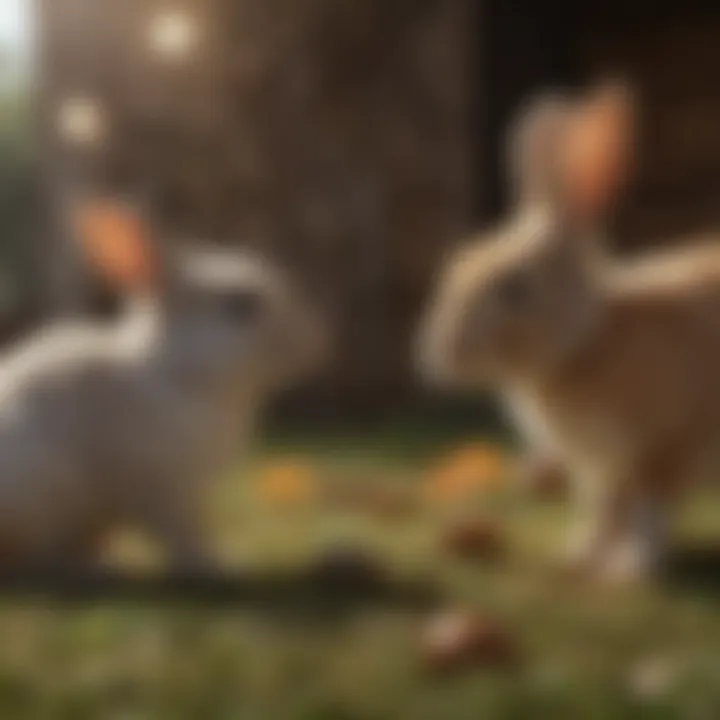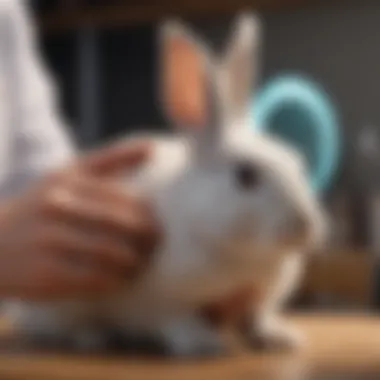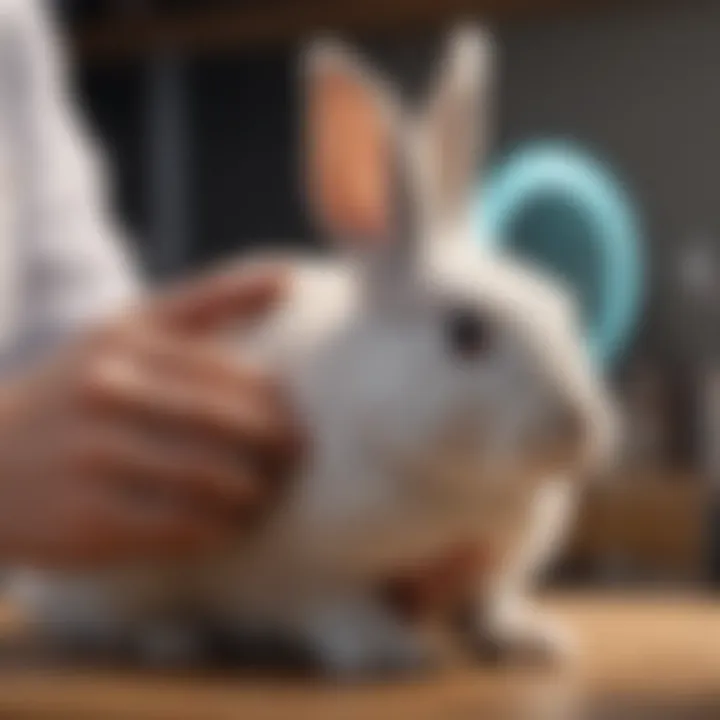Essential Needs for the Well-Being of Pet Rabbits


Intro
Pet rabbits are unique companions, requiring focused care to thrive in a domestic environment. Recognizing their essential needs is pivotal for pet owners aiming to ensure their well-being. This article will explore various topics including care tips, emotional requirements, nutritional guidance, health considerations, and enriching activities. By delving into these areas, owners can improve the quality of life for their rabbits while fostering a deeper bond between pet and owner.
Care Tips
Taking care of a pet rabbit encompasses daily routines, facility management, cleanliness protocols, and seasonal adjustments.
Daily Care Routines
Daily routines are fundamental for establishing a stable home for rabbits. Providing fresh water should be a priority. Ensure them access to clean, filtered water daily. Rabbits also require a balanced diet each day. It is crucial to offer hay, leafy greens, and specific pellets that desk at their nutritional foundation.
Cage Setup and Maintenance
The habitat for your rabbit must be secure and spacious enough to allow movement. Their cage should be well-ventilated and made from safe materials. Regular maintenance involves monitoring for wear. Remove leftover food or waste to maintain a tidy space.
Hygiene and Cleaning Practices
Keeping a rabbit’s living environment clean aids in their health. Develop a hygiene schedule that includes weekly thorough cleaning. In addition, weekly checks for waste build-up can prevent any health issues.
Seasonal Care Adjustments
Adjustments in care depending on the season are important. For summer months, ensure shade and plenty of water. In contrast, winter may require insulation and monitoring of temperature. Providing a comfortable environment suits their needs throughout the year.
Behavioral Insights
Understanding rabbit behavior is essential for building a sustainable relationship with your pet. Observing their body language, you can decipher their mood and comfort levels.
Understanding Rabbit Body Language
Rabbits exhibit distinct cues. Flopping or lying flat indicates relaxation. Ears up usually show alertness while thumping may indicate discontent. Recognizing these signals leads to informed actions.
Common Behavioral Issues and Solutions
Some rabbits may display undesirable behaviors, such as chewing furniture or litter box issues. Address chewin’ problems by providing chew toys and redirecting their attention. For litter concerns, consistent training and placement are essential.
Positive Reinforcement Techniques
Training rabbits requires patience and consistent rewards. Using treats to encourage positive behavior is effective. Verbal praise can also reaffirm good habits. Gradual training will result in better compliance from your rabbit.
Social Interaction Needs
Rabbits are social creatures, often longing for companionship. It is important to spend quality time interacting with them daily. Consider pairing them with other pets to enrich their social life, whilst ensuring the new companion is suitable.
Nutrition Guides
A well-balanced diet is key in keeping a rabbit healthy.
Essential Diet Components
Rabbit diets mostly consist of hay as their primary food. Fresh vegetables such as romaine lettuce, cilantro, or bell peppers provide necessary vitamins. Pellets should be given in moderation.
Safe and Toxic Foods
Some foods can be toxic. Avoid items such as chocolate, avocado, or potato plants. Know safe options and consult various resources to stay informed about foods for rabbits.
Supplements and Treats
Small amounts of treats can be healthy and enjoyable. Items such as small pieces of apple or small garden herbs are often favorites. Use supplements advised by vet professionals when necessary.
Feeding Strategies for Different Species
Consider individual rabbit circumstances, such as age and breed, when crafting a feeding plan. Young rabbits and older ones may have differing nutritional needs that warrant specialized diets.
Wellness and Health
Keeping your rabbit healthy requires vigilance.
Routine Health Checkups
Annual health inspections with a veterinarian help in preventing major concerns and ensuring well-being. Vaccinations save your pet from dangerous diseases.
Identifying Symptoms of Illness
It's crucial to monitor for signs indicating illness, such as changes in appetite or behavior. Lethargy and unusual droppings are often signs that needs prompt attention.
Preventative Care and Vaccinations
Following uphold a preventive care plan will aid avoidance of health issues. Regular vaccinations and consistent health check-ups safeguard the physical health of your rabbit.
Mental and Emotional Well-being
Don’t neglect mental health; provide stimulating activities. Hiding places or playtime enhances their mental state positively.
Enriching Activities
Engagement activities broaden a rabbit’s experience, stimulating physical and mental health.
Toys and Playtime Ideas


Introduce various toys like tunnels or chewables. Rotate options regularly to keep upward interest alive. Regular interaction platforms promote exercise.
Training and Tricks
Teach simple commands or tricks gradually. Short sessions with clear outcomes bear more success than lengthy training methods.
Outdoor Activities and Interaction
Supervised outdoor exposure encourages exploration while ensuring safety. Hopping freely in a contained area brings joy and energy.
DIY Projects for Mental Stimulation
Create fun mental activities, such as intriguing puzzles. Simple homemade toys can encourage interaction and stimulate curiosity.
By understanding and fulfilling the essential needs of pet rabbits, you foster not just a healthy environment, but a tools an enriching human-animal relationship.
Exploring these dimensions can equip rabbit guardians. Engaging in science of care enhances the duration of ewings. Enhancing understanding of these needs helps maintain not just physical wellness, but emotional and psychological health too.
Prolusion to Rabbit Care
The Importance of Understanding Rabbit Needs
Rabbits are intelligent and social creatures. They have unique behaviors and needs that differ from other pets. A good grasp of these needs enables owners to provide a suitable environment pivotal for their longevity and emotional health.
First, their living environment should promote comfort and security. Vital elements include space for exercise, safe structures for hiding, and the right kind of bedding. Recognizing these requirements fosters a trusting relationship between the owner and the rabbit.
Next, it is imporant that owners understand what a Rabbit's diet should consist of. Fresh hay, suitable vegetables, and clean water are core to their nutritional health. Owners who neglect these aspects could face multiple health issues for their rabbits. Additionally, good nutrition contributes to a rabbit's energy levels and promotes proper digestive health.
Social engagement cannot be overlooked. Rabbits do display a social structure, which means interaction with humans or other pets is substantive. Lack of interaction can lead to behavioral worries, anxiety, and a less fulfilling life for rabbits.
In summary, understanding rabbit needs is key to cultivating a happy and healthy home for them. It ensures that the physical and emotional aspects of rabbit care are being addressed. By investing time in this knowledge, pet owners can create an enriched life for their furry companions.
Creating a Suitable Living Environment
Creating a suitable environment for pet rabbits is fundamental to their well-being. A well-planned living space can prevent stress and contribute significantly to a rabbit's happiness and health. Given their natural instincts as prey animals, rabbits require both security and stimulation in their habitats. Understanding these needs can profoundly impact how rabbits behave and feel in their surroundings. As such, pet owners must invest time in setting up the right living conditions.
Indoor vs.
Outdoor Housing
When deciding on housing for rabbits, one must choose between indoor and outdoor settings. Each option carries benefits and downsides worth considering.
Indoor housing allows owners to monitor their rabbits closely. This permits timely interventions if behaviors cause concerns. Indoors also protect rabbits from rain, hail, and extreme temperatures. However, it often demands safeguarding critical items in the living area, as rabbits are known chewers, and they may cause property damage or harm themselves.
Outdoor housing might offer more space for exploration. With ample exercise, rabbits can exhibit more natural behaviors, keeping them engaged. Ultimately, outdoor housing demands significant protective measures against threats like predators. Creating a secure area with fencing, shaded places for rest, and rabbit-proofing against hazards are essentials for such settings. Choosing well-tailored housing serves the specific needs of your rabbit well.
Space Requirements for Rabbits
Space greatly influences a rabbit's mental and physical health. Rabbits thrive in spacious environments that allow them to hop freely and explore. Typically, a rabbit should have at least 12 square feet of living area inside their cage. Space should be expanded outside the cage, granting them room to run. Indoor setups might require enough room to safely navigate, particularly if using various toys and climbing structures.
Unrestricted movement promotes healthy activity and lessens boredom. Enabling this encourages natural behaviors, including hopping, chewing, and exploring. Thus, the spatial height of an enclosure also matters, particularly for breeds known for their jumping abilities. Inadequate space can lead to destructive behaviors or distress.
Bedding and Comfort
Proper bedding is another critical aspect of habitat requirements. Rabbits prefer soft, absorbent materials to create a cozy, comfortable spot. Standard bedding materials include straw, hay, or recycled paper products. Avoid cedar or pine shavings, as these can be harmful due to potential toxins.
Aside from safety, regular changes in bedding keep the living area hygienic. Maintaining cleanliness reduces sicking incidents by denying harmful bacteria's growths.
Think about small bedding details. Soft bedding can ease the wear on a rabbit’s paws. This care amounts to comfort as they move, play, and rest. Plus, including soft blankets or mats may provoke a sense of security within the enclosure, engaging your pet in relaxing activities.
A comfortable environment supports better mental health for a rabbit, allowing for peace of mind.
Nutritional Needs of Rabbits
Understanding the nutritional needs of rabbits is crucial for ensuring their overall health and well-being. A proper diet influences not only physical health but also behavior and emotional resilience. Rabbits are unique in terms of their digestive system, which requires specific types of foods to function optimally. It is essential to provide a balanced diet that includes the right proportions of hay, vegetables, fruits, and commercial pellets. Knowledge of these needs enables pet owners to avoid common health problems and promote a healthy lifestyle for their pets.
Understanding Rabbit Diets
Rabbit diets should be primarily composed of high-fiber foods. Fiber is essential for maintaining gut health and preventing digestion issues. Timothy hay or similar types of grass hay serve as the backbone of a rabbit's diet. It provides not just fiber, but also essential nutrients. Besides hay, fresh, leafy green vegetables should be a regular part of their diet. Good options include romaine lettuce, parsley, and kale.
It’s important to introduce new foods gradually to prevent tummy upsets. Pet owners should monitor any changes in a rabbit's behavior or digestion when trying new foods. Portion control is crucial, so as not to overfeed. Keeping hay available at all times is recommended.
What may exist in abundance can often be regarded as unnecessary. However, a rabbit that only receives an inadequate diet will not thrive. The bunny’s weight, energy level, and overall demeanor often signal when their dietary needs are not met.
Essential Foods and Supplements
A balanced diet is much more than just hay and vegetables. Pellets are often thought of as a primary food source. However, a good quality pellet should contain limited grains and excessive fillers. Formula generally should consist mostly of hay-based material and include little to no alfalfa for adult rabbits, as it can lead to obesity.
Some other food components to consider include:
- Safe, leafy green vegetables daily
- High-fiber hay in unrestricted quantity
- Limited fruits as occasional treats
Common supplements may include vitamin C and omega-3 fatty acids, particularly for rabbits that don't get enough natural exposure through their diet. Discussing any supplementation with a veterinarian is advised. They can provide guidance tailored to each rabbit’s specific needs.
Hydration and Water Accessibility
Water is just as critical as food for the health of rabbits. They should have fresh and clean water available at all times. Water can be provided in a bowl or bottles, but bowls are generally better as they allow rabbits to drink more easily. It is vital to ensure that the water supply is checked daily, refilling it as needed.
Hydration plays a significant role in digestion and prevents critical health problems. Monitor your rabbit for signs of dehydration, such as lethargy and loss of skin elasticity. It is essential to have unlimited access to water, especially if the rabbit's diet consists of pellets rather than high-fiber sources.


Consistent Accessibility to Water is Fundamental to Rabbit Health.
Social Interaction and Mental Stimulation
Understanding the social capabilities and mental stimulation requirements is crucial for ensuring the happiness and well-being of pet rabbits. Rabbits, as we will discover, are not solitary creatures by nature; their happiness correlates directly with their social interactions and mental engagements. Providing these facets in their daily lives not only enriches their environment but also fosters a healthier relationship between the rabbit and owner.
Benefits of Social Interaction
Rabbits who engage socially with owners, different animals, or other rabbits tend to be less anxious and exhibit fewer signs of stress. These animals thrive on companionship. Without adequate social needs being met, they can become bored, leading to destructive behaviors or unwanted health issues.
Consider that rabbits have complex social structures. They express emotions and establish hierarchies not just within their species, but empathically with humans. Therefore, understanding these intricacies can be powerful in cultivating rekationships that contribute positively toward a rabbit’s mental health.
The Social Nature of Rabbits
Rabbits are inherently sociable animals. They are usually governed by subtle social behaviors indicative of their instincts. Often, rabbits groom each other, nuzzle, and engage in playful acts as forms of communication and bonding.
Important Factors to Understand:
- Grooming: This is seen as a way of showing care. When rabbits groom each other, it strengthens their social relationship.
- Hierarchy: In wild settings, rabbits will establish a pecking order, often influencing their behavior in domestic settings.
- Communication: Rabbits communicate through body language, vocalizations, and by scent marking their territory. Observing these signals can help owners build trust and understanding with their pet.
A rabbit’s instinctive need for social connection means that they readily develop attachments to other rabbits or, alternatively, to humans.
It is essential to offer companionship in the form of another rabbit for single pets or to dedicate quality time daily if a lone rabbit is a household's choice. Not doing so can lead to behavioral problems that are distressing for the animal.
Toys and Activities for Mental Engagement
Providing a stimulating environment with appropriate toys and activities can improve a rabbit's mental health significantly. Boredom in rabbits can lead to frustration and stress; hence, it is essential for owners to introduce variety into a rabbit's playtime.
Recommended toys and activities include:
- Chew Toys: Products made from wood or untreated natural materials ensure safe chewing. Hence, it occupies them and helps maintain dental health.
- Interactive Games: Hiding food items around a structure made of cardboard can allow rabbits to forage, engaging their natural instincts.
- Obstacle Courses: Create a simple layout with tunnels and jumps. Moving through these stimulates their minds and bodies, contributing to healthier pets.
Engaging rabbits with toys and interactive play will not only keep them emotionally healthy, but it will also foster an environment of trust and companionship between pet and owner.
While toys and games are valuable, they must be rotated regularly to sustain interest, preventing monotony from settling in home habitats.
Ultimately, an investment in social interaction and mental stimulation stands as one of the most responsible ways to ensure your rabbit lives a joyful and enriching life.
Grooming and Hygiene
Grooming and hygiene play a crucial role in the overall health and well-being of pet rabbits. Regular grooming not only keeps their fur clean and free of knots but also serves to strengthen the human-animal bond. Rabbits can be sensitive creatures, and the grooming process can relax them. Providing proper hygiene care can reduce smell and the risk of health issues directly affecting their quality of life.
Regular Grooming Practices
Maintaining a consistent grooming routine is essential for rabbit care. It helps to monitor your rabbit's health and allows for early detection of potential issues. Some of the primary benefits of regular grooming include:
- Removing loose fur and dirt: Rabbits have soft fur that is prone to matting. Brushing helps to keep their coats smooth and clean.
- Preventing hairballs: While hairballs are more common in cats, rabbits can also be affected. Regular brushing helps minimize the risk.
- Monitoring skin health: During grooming, it's easier to check for signs of skin issues, bumps, or signs of parasites.
This grooming should be gentle and can be performed using a soft brush or comb. Around once a week is good for short-haired rabbits, while long-haired breeds may need daily grooming. This time in close interaction can also help develop trust between you and your rabbit.
Ear and Teeth Care
Ears and teeth care are important aspects of rabbit hygiene. These areas can be overlooked, but neglecting them can lead to serious health problems.
Ear Care
- Cleaning: Rabbit ears should be clean, without excessive wax or dirt buildup. Use a soft, damp cloth to gently wipe the inner parts of their ears without digging too deep.
- Regular checks: Examine ears for signs of redness, irritation, or mites. Any unusual changes should prompt examining by a vet.
Teeth Care
- Consistent dental health monitoring: Rabbits have continuously growing teeth. Overgrowth can lead to pain or mouth issues.
- Providing proper chewing materials: Ensure your rabbit has access to chew toys or hard food to aid their dental health.
Incorporating grooming into your routine enhances a rabbit's life. It is a bridge to better communication and understanding between the owner and the pet. Ensuring the rabbit’s grooming is properly addressed may significantly improve its overall quality of life.
Health Care Essentials
Understanding health care essentials is crucial for ensuring a long, fulfilling life for pet rabbits. Proper health maintenance can prevent illness, promote wellness, and enhance Quality of life. Owners should be knowledgeable about common health issues, preventive care, and the importance of regular veterinary check-ups. Adequate health care also includes being aware of signs that indicate a rabbit may require medical attention.
Common Health Issues and Signs
Pet rabbits can face several common health issues. Awareness of these issues is important for timely intervention.
1.
Gastrointestinal Problems Rabbits are prone to digestive disorders. Symptoms can include appetite loss, lethargy, or unusual droppings. It's critical to act quickly if these signs appear, as some issues can escalate rapidly.
2.
Dental Issues Rabbits have continuously growing teeth. Improper wear can lead to dental spurs, abscesses, or malocclusion. Look for signs like drooling or difficulty eating. Regular dental checks can avoid severe problems.
3.
Respiratory Infections A common condition in rabbits includes respiratory issues. Symptoms involve sneezing, nasal discharge, and difficulty breathing. Keeping them in a draft-free, warm environment can minimize risks.
4.
Ear Infections Ear infections can result from parasites or excess wax. Signs include head tilting, scratching, or discharge from the ear. Monitor your rabbit's ears for dirt and cleanliness.
Remember, noticing any changes in behavior can indicate a health issue.
Veterinary Care and Vaccinations


Regular veterinary care and vaccinations are fundamental aspects of rabbit health. Finding a vet experienced with rabbits is essential. Not all veterinarians have the same level of knowledge on rabbit care.
1.
Vaccination Needs Core vaccinations are significant in prevention. Diseases like viral hemorrhagic disease (VHD) or myxomatosis can pose serious risks. Consult with your vet on vaccination schedules to keep your rabbit protected.
2.
Annual Health Check-ups Routine health assessments should include weight checks, coat condition reviews, and dental inspections. Regular examinations allow the vet to catch potential issues early.
3.
Observation at Home In addition to routine visits, daily observations at home are equally important. Owners should be aware of their rabbit’s condition. Changes in eating habits, mobility, or litter box usage generally signal a need for veterinary attention.
Holistic planning encompassing preventative and restorative facets ensures that rabbits thrive in the homes of attentive pet owners.
Safety Considerations
Understanding safety considerations is paramount in the comprehensive care of pet rabbits. Rabbits, while relatively low-maintenance compared to some pets, are fundamentally vulnerable to various environmental and situational hazards. Adequate safety measures can help mitigate risks, preserving both the physical health and emotional safety of these animals. This section will focus on identifying potential hazards that may arise, as well as ensuring secure interactions between rabbits and other pets that may share the living space. It is essential for rabbit owners to continually evaluate their environment and interactions to maintain a safe haven for their furry companions.
Identifying Hazards in the Environment
Rabbits are inquisitive by nature, and their curiosity often leads them into harm's way. A responsible pet owner must actively rid the living area of any potential dangers. Identifying hazards requires careful observation and consideration. Here are some common hazards to be aware of:
- Toxic plants and chemicals: Many domestic plants can be harmful to rabbits, including philodendron, lilies, and azaleas. It's crucial to verify the safety of any plants buying or already possessing. Similarly, household cleaners, antifreeze, and some human foods can be toxic.
- Secure electrical cords: Rabbits have a tendency to gnaw on things. If they nibble on an electrical cord, the consequence can be dire. Use cord protectors or conceal cords to prevent access.
- Sharp objects: Items such as scissors, paper clips, or broken glass can cause severe injuries. Keep such objects out of reach.
- Furniture corners and edges: Certain furniture like desks or cabinets can pose risks with their sharp edges. Prevent access to these areas or create barriers to mitigate these hazards.
Ensuring a rabbit-safe environment includes considering every nook and cranny of the available space.
Regularly inspecting your rabbit's environment not only helps mitigate risks but also empowers you as an owner to safeguard the health and happiness of your pet. Keep in mind, even common household items can present unintended hazards.
Safe Interaction with Other Pets
When considering integrating a rabbit into a multi-pet environment, specific concerns arise. Preventing stressful or harmful interactions is essential for physical safety and emotional well-being. Introducing rabbits to dogs and cats, for example, comes with a necessary caution.
Here are key considerations for safe interactions:
- Supervised introductions: Always supervise early encounters between rabbits and other pets. Supervision allows for immediate intervention should tension arise.
- Understanding body language: Recognizing the body language of rabbits, dogs, and cats is essential. Certain postures and movements convey fear or aggression. Additionally, using safe spaces or barriers can help intuitively facilitate interactions.
- Slow acclimation: Introduced slowly and cautiously, other pets may learn to coexist with rabbits. However, gauging reaction is key. Never force an interaction.
- Habitats separation: Ensure that each pet has its own dedicated living space. Recognizing and honoring the natural behaviors of each species will foster respect.
Cautiously managing these relationships supports not only safety but also a harmonious household for all pets involved. In summary, prioritizing safety requires diligence. Regular checks of the environment and evidence-based introductions to other pets will promote the health, comfort, and overall well-being of pet rabbits. Personal vigilance goes a long way in establishing an ideal living condition for them.
Understanding Rabbit Behavior
Understanding rabbit behavior is crucial for enhancing the lives of pet rabbits and improving their integration into human households. Rabbits are social creatures with deep instincts and natural behaviors. To manage them effectively, pet owners should recognize the importance of behavioral cues, routines, and interactions. This awareness facilitates a more harmonious bond between rabbits and humans and enriches the rabbit's environment.
Communicating with Your Rabbit
Rabbits communicate in unique ways. They utilize sounds, body language, and even facial expressions. Being attentive to these signals offers insights into their needs and emotional states. Here are some communication methods used by rabbits:
- Ears Position: Erect ears can indicate curiosity, whereas flattened ears may signal annoyance or fear.
- Vocalizations: Gentle whimpers or soft grunts can express contentment or affection. In contrast, high-pitched squeals indicate distress.
- Body Posture: A relaxed posture shows comfort, while a crouched position may indicate apprehension.
Understanding such cues allows pet owners to respond appropriately, creating a capable and safe environment for their rabbits.
Establishing Trust and Bonding
Building trust with a rabbit takes time and patience. Establishing a connection fosters an emotional bond that meets the rabbit's social needs. Here are key considerations for developing trust with a rabbit:
- Gentle Approach: Start by allowing your rabbit to explore your presence. Avoid sudden movements that may frighten them.
- Consistent Routine: Rabbits thrive on predictability. A consistent schedule for feeding, grooming, and playtime contributes to a sense of security.
- Positive Reinforcement: Use treats or gentle petting to encourage desired behaviors. Rewards create a positive association with the activity.
The effort spent cultivating trust not only makes handling easier but also enriches the rabbit’s emotional welfare, ensuring it lives a happier and healthier life.
Proper communication and fostering trust are foundational to a positive human-rabbit relationship.
Epilogue: Integrating Rabbit Care Into Daily Life
Integrating rabbit care into daily life is crucial for both the well-being of pet rabbits and the overall harmony of the home environment. This process involves creating a structured yet flexible daily routine that caters to the dietary, social, and physical needs of these small animals. A well-thought-out daily plan not only enhances the rabbit's happiness but also helps strengthen the bond between the owner and the pet.
Consistency is key. Establishing a routine allows your rabbit to feel secure. Knowing that food, grooming, and playtime happen at set intervals fosters a sense of stability. Such predictable patterns can significantly reduce stress in rabbits, promoting healthier behavior.
Daily interactions must also be an integral part of the routine. Engaging your rabbit in social activities such as cuddling, gentle handling, or playing can stimulate their minds and nourish their affectionate nature. Rabbits are social creatures. Regular interactions with their owners help form trust and strengthen their attachment.
Developing an effective routine may require initial time investment. However, the long-term benefits far outweigh the effort. Below are specific elements to consider when integrating your rabbit's care into your daily life:
- Feeding Schedule: Provide fresh hay, vegetables, and pellets. Make sure to stick with the schedule to develop good eating habits.
- Grooming Sessions: Dedicate time weekly to groom your rabbit. This will help to keep them neat and comfortable, and can strengthen your relationship.
- Play and Exploration Time: Create daily opportunities for your rabbit to explore safely. This could involve supervised time outside their enclosure or allowing them free range in a rabbit-proofed space.
“Rabbits thrive in interactive environments. Engaging them not only fulfills their social needs but also enhances their emotional well-being.”
By establishing routines and adhering to them, rabbit owners can create an environment that is conducive to the pet’s health and happiness. Blocking out specific time to focus on the pet, regardless of how busy one's life feels, makes a significant difference in the emotional and physical quality of life for rabbits. The end result of this commitment is balanced care that meets essential needs while enriching the human-animal relationship.
Creating a Routine for Your Rabbit
Creating a routine for your rabbit involves several important steps that span feeding, socialization, exercise, and healthcare. When crafting a routine, personal flexibility and the unique personality of your rabbit must be considered.
Feeding
Rabbits benefit greatly from a consistent feeding schedule. It's best practice to feed them fresh hay, which should always be available, along with a limited amount of pellets once or twice a day at the same times. Fresh vegetables need to be introduced gradually and should follow careful selection to ensure they are suitable.
Exercising
Regular physical activity is important. Providing varied activities will result in a more fulfilled rabbit. You can create time slots where the rabbit can hop around freely in a safe environment. Toys should also be mixed in their living space.
Health Checks
Check their health at least weekly.* Routine checks include observing weight, examining fur for matting, and checking for any signs of health issues, always looking out for abnormalities.
Overall, integrating these actions into daily protocols makes them easier to manage. Over time, both rabbits and owners will benefit immensely by improving the rabbit's overall experience at home.















